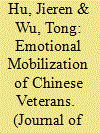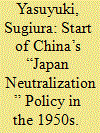| Srl | Item |
| 1 |
ID:
178745


|
|
|
|
|
| Summary/Abstract |
Based on in-depth interviews of Chinese veterans and specifically focusing on the cadets in Shanghai, this article explores the mechanism of emotional mobilization of this highly organized contentious group vis-à-vis other disorganized and dispersive one such as labors and homeowners. It reveals that strong emotional ties with comrades in troops and the despondency brought about by the Chinese Communist Party’s (CCP) ineffective redress to their demands have rendered Chinese veterans, who see themselves rhetorically glorified and embodying heroic status in the country, protesting for their military identity and military rank recovery for decades. In order to defuse veterans’ grievances, flexible governance, which stresses emotional care and affection by petition social workers, is deployed by the Party-state to settle disputes that beyond law and policy.
|
|
|
|
|
|
|
|
|
|
|
|
|
|
|
|
| 2 |
ID:
190138


|
|
|
|
|
| Summary/Abstract |
The Chinese Communist Party’s (CCP) Central Committee’s Measure and Plans for Policy Activities concerning Japan, formulated in March 1955, was China’s first Japan Policy Platform after the founding of the People’s Republic of China. It specified policy principles and measures. Its policy directed toward Japan could be called a “Japan neutralization” policy. There were three factors that contributed to the formulation of the Japan Policy Platform. The first factor was the start of full-fledged Japan-China private-sector exchanges and the CCP's aim to break away from a people's diplomacy toward Japan that centered on support for the Japanese Communist Party. The second factor was the major change in postwar Japanese politics with the resignation of the Yoshida Cabinet and the start of the Hatoyama Cabinet. The third factor was the change in foreign policy, with the reintroduction of the “Theory of Intermediate Zones” and the international environment, with the advent of the Sino-Soviet honeymoon period and the intensification of the US-China confrontation.
|
|
|
|
|
|
|
|
|
|
|
|
|
|
|
|